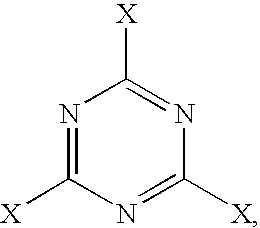Crosslinkable, cellulose ester compositions and films formed therefrom
a technology of cellulose ester and composition, applied in the direction of cellulosic plastic layered products, instruments, polarising elements, etc., can solve the problems of unsatisfactory photographic roll films, many kinds of optical films, toxic and environmentally unfriendly, etc., and achieve the effect of improving dimensional stability and mvtr
- Summary
- Abstract
- Description
- Claims
- Application Information
AI Technical Summary
Benefits of technology
Problems solved by technology
Method used
Image
Examples
##ic example 1
Prophetic Example 1
1. Preparation of Dope Composition
[0078] The dope components set forth in Table 1 are charged to a closed vessel and heated to 60° C. The cellulose acetate propionate (CAP) is completely dissolved with stirring to obtain a dope. The time required for dissolution is 4 hours. The dope composition is filtered and, while being maintained at 35° C., is uniformly cast on a stainless steel band support maintained at 30° C.
TABLE 1INGREDIENTPARTS BY WEIGHTcellulose acetate propionateA100methyl ethyl ketone550triphenyl phosphate10melamine crosslinking agentB15p-toluene sulfonic acid0.4light stabilizer / UV absorberC0.1UV light absorberD0.1UV light absorberE0.2
A46% by weight propionyl; available from Eastman Chemical Company under the name CAP 480-20.
BCYMEL ® 303, available from Cytec Industries, Inc.
CTinuvin ® 326, available from Ciba.
DTinuvin ® 109, available from Ciba.
ETinuvin ® 171, available from Ciba.
[0079] The dope is peeled from the stainless band support afte...
##ic example 2
Prophetic Example 2
1. Preparation of Dope Composition
[0081] The dope components set forth in Table 2 are charged to a closed vessel and heated to 60° C. The cellulose acetate butyrate (CAB) is completely dissolved with stirring to obtain a dope. The time required for dissolution is 4 hours. The dope composition is filtered and, while being maintained at 35° C., is uniformly cast on a stainless steel band support maintained at 30° C.
TABLE 2INGREDIENTPARTS BY WEIGHTcellulose acetate butyrateA100acetone550triphenyl phosphate10melamine crosslinking agentB15p-toluene sulfonic acid0.4light stabilizer / UV absorberC0.2UV light absorberD0.1UV light absorberE0.2
A35.5% by weight butyryl; available from Eastman Chemical Company under the name CAB 381-20.
BCYMEL ® 303, available from Cytec Industries, Inc.
CTinuvin ® 326, available from Ciba.
DTinuvin ® 109, available from Ciba.
ETinuvin ® 171, available from Ciba.
[0082] The dope is peeled from the stainless band support after it is dried to...
##ic example 3
Prophetic Example 3
1. Preparation of Dope Composition
[0085] The dope components set forth in Table 3 are charged to a closed vessel and heated to 70° C. The cellulose acetate butyrate (CAB) is completely dissolved with stirring to obtain a dope. The time required for dissolution is 4 hours.
TABLE 3INGREDIENTPARTS BY WEIGHTcellulose acetate butyrateA100methyl ethyl ketone550triphenyl phosphate10isocyanate crosslinking agentB25
A35.5% by weight butyryl; available from Eastman Chemical Company under the name CAB 381-20.
Bblocked polyisocyanate based on hexamethylene diisocyanate; available from Bayer Material Science under the name DESMODUR ® BL 3370 MPA.
2. Preparation of Retardation Increasing Agent Solution
[0086] A retardation increasing agent is prepared by charging the ingredients of Table 4 to a mixing tank and stirring until each component is dissolved.
TABLE 4INGREDIENTPARTS BY WEIGHTris(m-methylanilino)melamine20UV light absorberA0.1UV light absorberB0.1methyl ethyl keton...
PUM
| Property | Measurement | Unit |
|---|---|---|
| thickness | aaaaa | aaaaa |
| thickness | aaaaa | aaaaa |
| temperatures | aaaaa | aaaaa |
Abstract
Description
Claims
Application Information
 Login to View More
Login to View More - R&D
- Intellectual Property
- Life Sciences
- Materials
- Tech Scout
- Unparalleled Data Quality
- Higher Quality Content
- 60% Fewer Hallucinations
Browse by: Latest US Patents, China's latest patents, Technical Efficacy Thesaurus, Application Domain, Technology Topic, Popular Technical Reports.
© 2025 PatSnap. All rights reserved.Legal|Privacy policy|Modern Slavery Act Transparency Statement|Sitemap|About US| Contact US: help@patsnap.com



